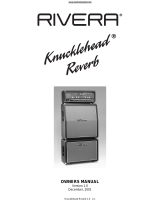
Rear Panel Features and Functions
Input From Amplifier: Connect this jack to the output of your amplifier. Be sure to set the
impedance on your amplifier to match the impedance of the RockCrusher Z Selector on the front panel, as well as the
speaker(s) connected to the Speaker jacks. Use only proper speaker cables.
Speaker Outputs: For connection to Speaker Cabinets. These jacks are connected in parallel.
Suitable for one 8 Ohm speaker cabinet, or one or two 16 Ohm Speaker Cabinets. Do not connect to lower than a combined
load of 8 Ohms maximum. Use Speaker 1 first when connecting speakers. Use only proper speaker cables.
Unbalanced Line Out: For connection to any unbalanced input of recording or PA gear. It can also be connected to a Power
Amplifier in order to power additional cabinets. It is always live, and works in either Bypass, Attenuation, or Load Box modes.
Use a shielded cable for these connections.
Balanced Line Output: For connection to any balanced input of recording or PA gear. It can also be connected to a power
amplifier in order to power additional cabinets. It is always live, and works in either Bypass, Attenuation, or Load Box modes. It
is transformer coupled, and should be used for the highest quality connection. Since the signals are floating from ground, it
can also help alleviate potential ground loops between the Amplifier and the recording or PA equipment. Use a quality XLR 2
conductor with braided shield cable for these connections.
QUICKSTART-when using as Power Attenuator
1. Set your amplifier to the correct impedance to match your intended speaker load impedance.
2. Set the RockCrusher to the same impedance as your amplifier.
3. Connect the Input of the RockCrusher to the speaker output of your amplifier with a 18 Gauge Speaker
Cable (recommended minimum is 16 Gauge or larger). Do not use shielded guitar cables ever to connect
amplifier outputs to RockCrusher inputs.
4. Connect the Speaker jacks of the RockCrusher to your speaker cabinets with a proper speaker cable
(see above). If you wish to use the RockCrusher as a Load Box, be sure the front panel Function switch is
set to Attenuator position.
5. Connect the Line Output to your recording or PA equipment.
6. If using as an Attenuator, start by selecting Bypass from the front panel Function switch.
7. Adjust the controls on your amplifier to the desired sound. Now select Attenuator from the Function
switch, and adjust the Attenuation Level and your amplifiers levels to obtain the desired sound and output
stage distortion.
8. If using as a Load Box, make sure the Function Switch is in the Attenuate position, and monitor the signal
coming out of your Line Outputs.
QUICKSTART-when using as Loadbox
1. Set your amplifier to the correct impedance to match your intended speaker load impedance.
2. Set the RockCrusher to the same impedance as your amplifier.
3. Connect the Input of the RockCrusher to the speaker output of your amplifier with a 18 Gauge Speaker
Cable (recommended minimum is 16 Gauge or larger). NEVER use shielded guitar cables to connect
amplifier outputs to RockCrusher inputs.
4. Connect the Line or XLR Output to your recording or PA equipment.
5. Make sure the Function Switch is in the Attenuate position, and monitor the signal coming out of your Line
Outputs.
QUICKSTART-Setting EQ
1. Adjust PAD switch for level matching (example a 5watt amps might need min PAD, 100watt amps might need
maximum PAD. This is to avoid clipping the EQ)
2. Set EQ switch to on position and adjust all level controls “Flat” which is at the 0 position.
3. Adjust EQ according to taste.
To mixer or recording A/D
interface
Use included power adapter
with correct polarity (tip
positive, ring negative)








